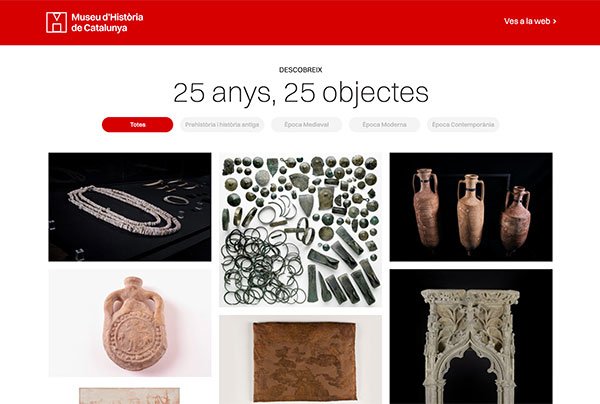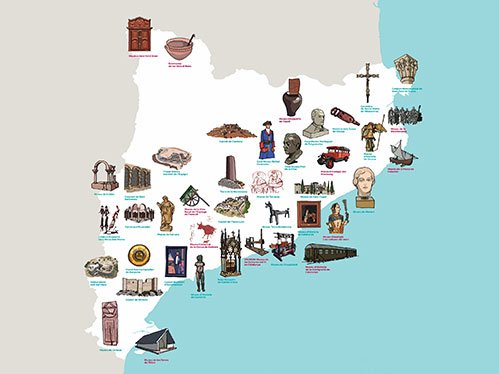Al canviar d'idioma no tots els continguts estan traduïts
The website is not fully translated
Al cambiar de idioma no todos los contenidos están traducidos
Al canviar d'idioma no tots els continguts estan traduïts
 Opening times
Opening times
 Location
Location
 Tickets
Tickets
 Admissions
Admissions
Opening times
Tuesday to Saturday, 10am to 7pm
Wednesdays, 10am to 8pm
Sundays and public holidays, 10am to 2.30pm
The ticket office and entrance are closed 30 minutes before closing time
CLOSED: Mondays that are not bank holidays, 1 and 6 January, 1 May, 18 May, 1 June, 25 and 26 December
Location
Address
Plaça de Pau Vila, 3
08039 Barcelona
Coordinates: 41.380900, 2.185693
Contact
932 254 700
mhc.cultura@gencat.cat
Fax 932 254 758
Group and school bookings:
932 254 244
Monday to Thursday: 10am-2pm and 3.30-5.30pm
Friday: 9.30am-2pm
mhcvisites.cultura@gencat.cat
Transport and access routes
Public transport
Buses V17, H14, D20, V15, V13, 39, 45, 51, 59 and 120
Metro L4 (yellow) Barceloneta
Train to Barcelona Estació de França
Barcelona Tourist Bus: red line; and Barcelona City Tour: eastern route; Museu d’Historia de Catalunya stop.
Parking
There are three paid-for car parks nearby: in Passeig Joan de Borbó, Moll d’Espanya and Moll de la Fusta.
Coaches have parking spaces available near the museum building.
“Bicing” bicycle hire in Plaça Pau Vila.
Admissions
Permanent exhibition
Temporary exhibitions
General admission: 4 euros
Reduced admission: 3 euros
Combined ticket
Permanent exhibition + temporary exhibition
General admission: 8 euros
Reduced admission: 6 euros
 Opening times
Opening times
 Location
Location
 Tickets
Tickets
 Admissions
Admissions
Opening times
Tuesday to Saturday, 10am to 7pm
Wednesdays, 10am to 8pm
Sundays and public holidays, 10am to 2.30pm
The ticket office and entrance are closed 30 minutes before closing time
CLOSED: Mondays that are not bank holidays, 1 and 6 January, 1 May, 18 May, 1 June, 25 and 26 December
Location
Address
Plaça de Pau Vila, 3
08039 Barcelona
Coordinates: 41.380900, 2.185693
Contact
932 254 700
mhc.cultura@gencat.cat
Fax 932 254 758
Group and school bookings:
932 254 244
Monday to Thursday: 10am-2pm and 3.30-5.30pm
Friday: 9.30am-2pm
mhcvisites.cultura@gencat.cat
Transport and access routes
Public transport
Buses V17, H14, D20, V15, V13, 39, 45, 51, 59 and 120
Metro L4 (yellow) Barceloneta
Train to Barcelona Estació de França
Barcelona Tourist Bus: red line; and Barcelona City Tour: eastern route; Museu d’Historia de Catalunya stop.
Parking
There are three paid-for car parks nearby: in Passeig Joan de Borbó, Moll d’Espanya and Moll de la Fusta.
Coaches have parking spaces available near the museum building.
“Bicing” bicycle hire in Plaça Pau Vila.
Admissions
Permanent exhibition
Temporary exhibitions
General admission: 4 euros
Reduced admission: 3 euros
Combined ticket
Permanent exhibition + temporary exhibition
General admission: 8 euros
Reduced admission: 6 euros
In París, engagé
During the 1960s and 1970s, Antoni Tàpies’ combative art against the Franco regime enjoyed a privileged platform in Paris, as part of his exhibitions at the Maeght Gallery. In the 1967, 1972 and 1974 shows, he produced several large protest posters that were displayed in the city, featuring dissident messages that were impossible to display in Franco’s Spain, such as the four bars [of the Catalan flag] or the term “assassins”. Symbols and proclamations that he displayed in the exhibitions through pictorial, object or graphic works, as well as in specific publications of the gallery, such as Derrière le Miroir. The Catalan flag as a symbol of protest occupied a special place in homage to Joan Miró at the Moulin de la Galette, on the occasion of his exhibition at the Grand Palais in Paris in 1974, which brought together a representative group of Catalan artists and intellectuals.

París, 1950s
Antoni Tàpies was well acquainted with Paris, having spent six months there between 1950 and 1951 on a scholarship from the French Institute in Barcelona. He first moved into the College of Spain in the university city and then to Saint-Cloud (Paris), where he came into contact with his Catalan colleagues, his cousin Modest Cuixart and Enric Tormo. In Paris, he also visited the poet and diplomat João Cabral de Melo, collaborator of Dau al Set, who introduced him to the philo-communist readings of Karl Marx, Friedrich Engels, Roger Garaudy, Henri Lefebvre and Jean Kanapa. His Parisian work explicitly expressed his concern about the oppression and alienation of man within the context of capitalism and dictatorship – Personatge i reixes (Figure and Bars) (1950), Ells acusen (They Accuse) (1951) and Sèrie Història Natural (Natural History Series) (1950) – as well as his interest in committed poets such as Federico García Lorca or Rafael Alberti. Concerns that he shared in letters with his friend the poet Joan Brossa, who remained in Barcelona.
Opening times
Tuesday to Saturday, 10am to 7pm
Wednesdays, 10am to 8pm
Sundays and public holidays, 10am to 2.30pm
The ticket office and entrance are closed 30 minutes before closing time
CLOSED: Mondays that are not bank holidays, 1 and 6 January, 1 May, 18 May, 1 June, 25 and 26 December
Location
Address
Plaça de Pau Vila, 3
08039 Barcelona
Coordinates: 41.380900, 2.185693
Contact
932 254 700
mhc.cultura@gencat.cat
Fax 932 254 758
Group and school bookings:
932 254 244
Monday to Thursday: 10am-2pm and 3.30-5.30pm
Friday: 9.30am-2pm
mhcvisites.cultura@gencat.cat
Transport and access routes
Public transport
Buses V17, H14, D20, V15, V13, 39, 45, 51, 59 and 120
Metro L4 (yellow) Barceloneta
Train to Barcelona Estació de França
Barcelona Tourist Bus: red line; and Barcelona City Tour: eastern route; Museu d’Historia de Catalunya stop.
Parking
There are three paid-for car parks nearby: in Passeig Joan de Borbó, Moll d’Espanya and Moll de la Fusta.
Coaches have parking spaces available near the museum building.
“Bicing” bicycle hire in Plaça Pau Vila.
Admissions
Permanent exhibition
Temporary exhibitions
General admission: 4 euros
Reduced admission: 3 euros
Combined ticket
Permanent exhibition + temporary exhibition
General admission: 8 euros
Reduced admission: 6 euros




 Twitter
Twitter Facebook
Facebook